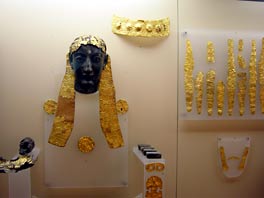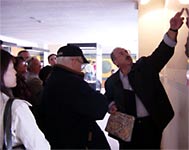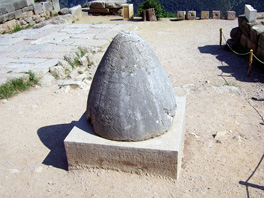| |


 |
 |
 |
 |

Three chryselephantine life-size heads of statues impress us a lot.
Unfortunately only part of these masterpieces survived through the
years and we can see now the two heads in good condition as well as
parts of their arms, feet and toes. Archeologist say that they
portrayed god Apollo (the one at the picture), his sister, goddess
Artemis/Diana and the third head (the one that is not that well
reserved) is believed to be part of the statue of their mother, Leto.
As I see them, the question that instantly comes into my mind is why
the ivory is black instead of white, as it should be. The guide
informs us that ivory turns black when it’s burned. Particularly the
oracle of Delphi has often been hit by earthquakes and fires. In
case of fire it was a habit, at that time, to burry the precious
monuments and objects, so as to protect them. Thanks to that, these
particular exhibits survived looting through the centuries. It is
also the reason why the were discovered by chance after more 30
years of the beginning of the excavation in the Delphi site.
|
 |
 |
 |
 |


Address: Delphi 33054, Fokida

Operation Hours:
April to October 07.30-19.30
+30-22650-82312
Full admission: 6 Euro
Reduced admission: 3 Euro
Ticket for both museum and site: 9 Euro
Tips for museums' admission
|
|
© Copyright 2004-2012 www.delphic-oracle.info
|
|








 As
we enter the museum we stop in front of a map of the Archaeological
Site of Delphi. The museum, I
would say, is an integral part of the sanctuary, with
exhibits from the site of Delphi.
Our tour in the museum begins…
As
we enter the museum we stop in front of a map of the Archaeological
Site of Delphi. The museum, I
would say, is an integral part of the sanctuary, with
exhibits from the site of Delphi.
Our tour in the museum begins… One can admire from shields and helmets of ancient warriors to
safety pins (yes, ancient Greeks used safety pins for their clothes,
since they had not buttons!!), statues, columns, friezes and metopes
from the buildings and temples that are nowadays unfortunately
destroyed.
One can admire from shields and helmets of ancient warriors to
safety pins (yes, ancient Greeks used safety pins for their clothes,
since they had not buttons!!), statues, columns, friezes and metopes
from the buildings and temples that are nowadays unfortunately
destroyed. ...but
to tell you the truth, shields cannot impress me a lot, while I am
in the museum of Delphi...
...but
to tell you the truth, shields cannot impress me a lot, while I am
in the museum of Delphi...